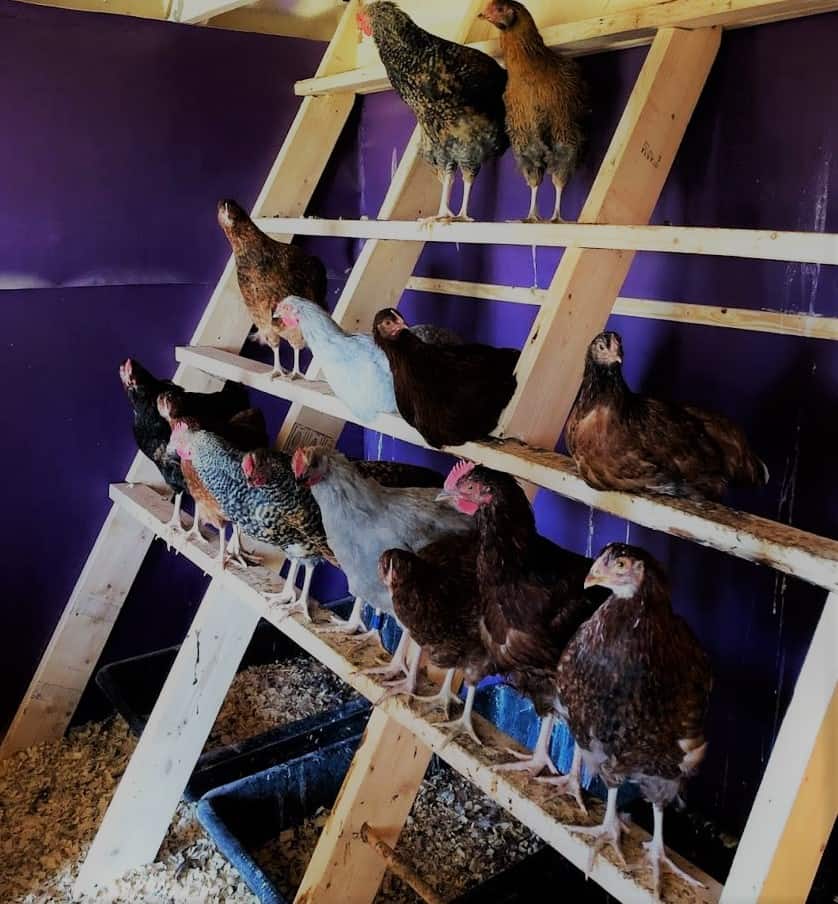Keeping backyard chickens as part of a homestead has increased in popularity over recent years. There are many factors to consider when keeping chickens, from what they eat to where they sleep.
An important aspect is chicken roosts, but what are they? And do chickens actually need them?
Chickens, by instinct, need to roost at night for a few reasons. When chickens roost, they are above the ground and are, therefore, out of reach from ground-based predators and rodents. Chickens are removed from potential external parasites and bacteria, and they are not standing in their feces.
Chickens are genetically programmed to roost at night, but what type of roost do they like? How high should the roosts be? How many roosts should you have?
Where should the roost be located and how much space do chickens need to roost?

A Guide To Chicken Roosts
What is a Roost?
A chicken roost is an area where chickens sleep for the night, while a perch is what they sleep on.
At night chickens will fly/climb up to the highest possible point accessible to sleep for the night. Our chickens had access to trees, and, like clockwork, the sun would be setting and the chickens would be climbing up the branches to roost for the night.
When setting up a roost, there are some essential points to keep in mind:
Roost Height
As I’ve mentioned, chickens will attempt to get to the highest point, so when constructing your roost, make sure you don’t have any other “climbable/perch-able” surfaces higher than the roost. The minimum recommended height that a roost should be is 18 inches above the ground.
There really is no maximum height; however, if you go higher than around 24 inches, chickens need “ladders” or steps to climb up. This prevents the chickens from landing on the hard floor, as it can lead to injuries and diseases, like “Bumblefoot” (a bacterial infection). A good range is between 18 and 36 inches.
Note: It is important to note that chickens have a hierarchy. There are more dominant and less dominant birds. This hierarchy is established through scuffles and fights.
The most dominant birds will be at the top of the roost (with the ruler of the roost right on top!) descending downwards (especially if space is limited), with the least dominant closest to the ground, and predators. In order to prevent fights for the top spot, roosts should be as uniform in height as space allows.
If space is a factor and you need to have multiple tiers of roosts, then make sure to leave enough of a gap between the perches/roosts (approximately 15 inches) to avoid birds on top defecating on birds lower down.
Roost Width (footing)
A chicken’s foot needs to fit on top of the perch (a chicken does not close its foot around a perch). An excellent guide to follow is between two and five inches in diameter, as long as the chicken can balance on top. The size will also vary depending on your chicken breed.
A wider perch allows for chickens to sit over their feet, an essential consideration for areas that have colder weather, where frostbite is a concern.
Roost Materials
When it comes to choosing materials, simple is best.
Tree branches are cost-effective and add an aesthetic appeal; however, chickens can also roost on lumber (two-by-twos are a popular choice) or even rubberized poles. Try to avoid metal and plastic as they can create a slippery surface and the heat and cold are negative factors as well.
A perch needs to be even, with no sharp edges. Anything that can break the skin of the chickens’ feet can cause “bumblefoot” by allowing bacteria into the cut.
Most chicken farmers use untreated lumber (2×2 or 2×4); with its flat, wider surface, the chickens are provided a better area to stand on. I used 2×2’s in the coop that I built and the chickens used it easily.

Roost Location
This is another crucial factor. Chickens poop while roosting. A lot! The roost’s location needs to be in an area that can be cleaned efficiently and where the feces can fall without causing health concerns. Avoid placing a roost over:
- Nesting boxes– aside from diseases, chickens are less likely to use dirty nesting boxes for egg-laying.
- Walkways– when chickens walk through or stand in feces, they can contract bacterial and fungal infections.
- Feeders and water units– don’t poop where you eat! Chickens need fresh water and don’t need to drink their waste.
- Entrances– try not to block entrance points with roosts; it just makes for easier cleaning and access to the coop.
Roost Number and Spacing
Chickens roost side by side on a perch. Each chicken needs around eight to ten inches of space along the perch.
Although they will stand closer in colder weather, and to balance, this guideline allows for the heat of summer and room for error. It’s better to have more than less space!

Nesting Boxes Vs. Roosts, Where Should A Chicken Sleep
I’m sure we’ve all seen enough movies and cartoons where chickens go to sleep in nesting boxes for the night.
Although this is not inherently wrong, there are some downsides to letting your chickens sleep in their nesting boxes:
- Chickens defecate while sleeping. This means that every morning, you will be cleaning chicken poop out of nesting boxes.
- Another problem with chickens defecating in their nesting boxes is that dirty boxes discourage hens from using them for egg-laying.
- Chickens that sleep in their nesting boxes are more inclined to start eating their eggs (this was a huge problem I had with my chickens as well). So if you can discourage chickens from spending unnecessary time in the nesting boxes, then you are heading in the right direction!
These issues, although not life-threatening, are good reasons to opt for roosts over nesting boxes.
Roosts need to be placed higher than nesting boxes in the chicken coop, as this will encourage chickens to sleep on the roost instead.
The benefits of having a roost for your chickens are high.
Not only does it allow for their instinctive behavior to be satisfied; remove the chickens from potential predators (mice and rats included), and prevent them from standing in ectoparasites and bacteria, but you can also place a catching try under the roosting chickens in order to catch the feces.
This means easier cleaning and you can “harvest” the manure for composting, a very sought-after fertilizer.
Roost Designs
The design of your chickens’ roost is limited to your imagination, resources and space available.
Most homesteading chicken farmers opt for a simple design.
This usually is a perch (2×4 timber, tree branch, rubberized pole, etc.) anchored between two or more supports (depending on the length).
The benefit of this design is that you can have multiple long lines of roosting chickens with little risk of fighting for the highest perch. The downside is you require a lot of space.
An old ladder or staircase design is also quite frequently used.
As the name implies, this can be made by using an old ladder or by building a staircase. This is a good design for when space is a bit limited inside your coop.
Use the shape of a ladder as your guide. Use two vertically placed poles/pieces of timbre, which are at an angle, with two-by-four beams spanning the distance to create the “rungs” of the ladder.
Each rung (or step) should be between 12 and 18 inches apart. This allows enough space to avoid chickens defecating on one another. The structure will usually lean against a wall/fence.
An alternative to this design would be building two sides and joining them in the middle, creating an “A-frame” shape.
Whatever your design, it needs to be stable, even, accessible, and provide your chickens with a safe place to roost for the night.

Conclusion
Chickens will continue to be a popular choice for homesteading. They are relatively simple to keep and have many benefits. But, to ensure healthy, happy birds, we need to make sure their essential needs are met.
This means providing them with good, stable, adequate roosting space!




